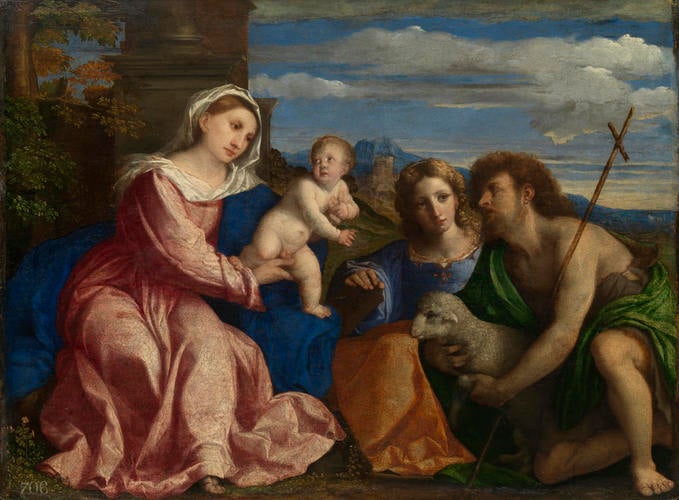-
1 of 253523 objects
The Virgin and Child with Saints Catherine of Alexandria and John the Baptist c. 1527-8
Oil on poplar panel | 60.0 x 81.5 cm (support, canvas/panel/stretcher external) | RCIN 405723

Palma Vecchio (active 1480-1528)
The Virgin and Child with Saints Catherine of Alexandria and John the Baptist c. 1527-8
-
This successful formula of the Virgin and saints in a landscape was one of Palma’s specialities. His dynamic, focused compositions, such as this, were inspired by Titian. Christ looks back at his mother, not wishing to accept the lamb, symbol of his destiny, from St John. This painting was in the collection of Charles I. When it entered the collection the panel was thinned and laminated to a thin coniferous panel (3 mm) and then to an oak back panel (7 mm), to which a Charles I brand was applied. This treatment was complex, finely executed and highly unusual for this date. The losses along the grain of the panel may have been caused by this early restoration. The painting has a pronounced craquelure, resulting from the upper paint layers drying more quickly than the lower, but the jewel-like colour combinations have survived almost perfectly. Especially striking are the brilliant gold-orange and violet-blue in St Catherine’s drapery and the touches of gold at her neck and hair. Palma Vecchio developed this successful formula of the Virgin and Child and saints seated in an idyllic landscape from more static, hierarchic half-length groups by earlier Venetians, such as Giovanni Bellini, and from compositions by Alvise Vivarini and Jacopo de’ Barbari treating such subjects as the ‘Madonna of Humility’ (where the Virgin sits on the ground), the 'Adoration of the Shepherds' and the 'Rest on the Flight into Egypt'. Palma was conservative with his theme, but was inspired by his more revolutionary contemporary, Titian, to develop more dynamic and focused compositions and to integrate his heroic, richly dressed figures into a poetic, sunlit landscape. The pastoral idyll was a Venetian speciality, seen elsewhere in the paintings of Giorgione and the poetry of Jacopo Sannazaro, Pietro Bembo and Fra Francesco Colonna. Palma reconfigured the figures to create many variations on this theme; these ‘sacre conversazioni’ were much in demand by the Venetian middle class for private devotion (or decoration) rather than as grand altarpieces in public churches. This is generally accepted as a fine autograph late work by the artist. The figure of John the Baptist had already appeared in two previous paintings: 'The Virgin with Saints Catherine, John the Baptist and two Female Saints' (c.1520-22; Kunsthistorisches Museum, Vienna) and 'The Virgin with Saints John the Baptist, Peter and a Female Saint' of 1523-6 (Glasgow Art Gallery and Museum). This third appearance, however, is the most successful and complex. Philip Rylands noted that the pose of the Christ Child derives from Lorenzo Luzzo’s 'Virgin Enthroned with Saints Stephen and Liberale' (Gemäldegalerie, Berlin) of 1511, painted for the church of Santo Stefano, Feltre, which also influenced Palma’s 1527-8 altarpiece in Santo Stefano, Vicenza. Compared with his earlier work, Palma designed this composition to be compact and focused. The interchange of glances between the two saints is intense, as Christ looks anxiously back at his mother, not wishing to accept the lamb, the symbol of his destiny. The broadly painted folds of drapery and softer transitions of planes, retaining intense colours, contrast with the more meticulous style and sharper folds of the larger Vienna painting. The ample sweeps of drapery recall those of Palma’s majestic figure of St Barbara in the church of Santa Maria Formosa, Venice, of the same date. Catalogue entry adapted from The Art of Italy in the Royal Collection: Renaissance and Baroque, London, 2007
Provenance
By 1629 in collection of Charles I; recorded in the Cabinet Room at Whitehall in 1639 (no 37); probably the picture sold for £225 to Jan Baptiste Gaspars on 22 March 1650 from St James's Palace (no 112); recovered at the Restoration and listed in the King's Closet at Whitehall in 1666 (no 307)
-
Creator(s)
Acquirer(s)
-
Medium and techniques
Oil on poplar panel
Measurements
60.0 x 81.5 cm (support, canvas/panel/stretcher external)
76.0 x 96.3 x 4.5 cm (frame, external)
Category
Object type(s)
Other number(s)
Alternative title(s)
A sacra conversazione: The Virgin and Child with Saints Catherine of Alexandria and John the Baptist